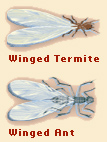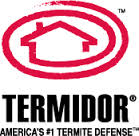There are about 2000 known species of termites throughout the world. In the U.S., Subterranean Termites, including Eastern, Western, Desert and Formosans, which build underground nests, are a concern in every state except Alaska. Subterranean termites are extremely destructive, because they tunnel their way to wooden structures (like your home), into which they burrow to obtain food. Termites all share a virtually insatiable appetite for wood and other cellulose-containing materials. Given enough time, they will feed on the wood until nothing is left but a shell.
Learn more…
A Caste of Hundreds of Thousands
Termites are highly social insects that live in large colonies where populations can reach more than one million. A colony consists of several structurally differentiated forms living together as castes (including reproductives, soldiers, and workers) with different functions in community life.
 Both ants and termites have two pairs of wings, but ants’ wings are different sizes while the termites’ wings are all the same size. Also, ants have narrowed waists and elbowed antennae while termites have thick waists and short, straight antennae that resemble strings of beads. Don’t be fooled by color or size. Ants can vary in size, and winged termites can be brown or black like ants.
Both ants and termites have two pairs of wings, but ants’ wings are different sizes while the termites’ wings are all the same size. Also, ants have narrowed waists and elbowed antennae while termites have thick waists and short, straight antennae that resemble strings of beads. Don’t be fooled by color or size. Ants can vary in size, and winged termites can be brown or black like ants.
You’re more likely to discover you have a termite problem by discovering the evidence they leave behind rather than the actual termites themselves. If you encounter any of these telltale signs, there’s a good chance termites are busy snacking on your home:
- Piles of small, delicate wings shed by reproductives
- Small piles of sawdust
- Mud tubes built by termites for aboveground travel
- Damaged or hollow sounding wood
- Pinholes in drywall or wallpaper
Of course, it’s quite possible to have a hidden termite problem even if you never notice any of these signs. The best way to be sure is to contact a licensed pest control professional, like Spears Pest Control at 850-682-5354, to conduct a complete inspection of your home.
Eastern Subterranean Termites

The Eastern Subterranean termite is the most common and most widely distributed termite in North America. It is a problem for home owners from southern Ontario in Canada, south throughout the Eastern United States and as far west as Montana.
This native American pest feeds on such cellulose materials as structural wood, wood fixtures, paper, books, and cotton. Occasionally, it will even attack the roots of shrubs and trees.
A mature colony of Eastern Subterranean termites can range from a low of 20,000 to a high of 5 million workers, with an average of 300,000. The colony’s queen will add 5,000 to 10,000 eggs per year to the total.
While Eastern Sub termite colonies are not the largest termite colonies you can find, there will often be more than one of them working in a single building. Signs of Easterns include dirt-colored tubes built to serve as protected paths from the earth to the wood the termites are feeding on, and the translucent wings shed by the kings and queens during swarming. Swarming usually occurs in the spring, but other, smaller swarms can occur throughout the summer and fall.
Some quick facts about Eastern Subs
- An average Eastern Sub termite colony can consume 5 grams of wood per day, the equivalent of 2 1/3 linear feet of a 2’x4′ pine board annually.
- Colony growth is slow, and it may take years before swarmers are produced.
- Eastern Sub termites can enter buildings through cracks less than 1/16″ wide.
- The termite colony is made up of different types (castes) of termites – each with separate work responsibilities.
- Although Eastern Sub termite colonies are largely located in the ground below the frost line, secondary colonies can exist above ground, and examples of true above ground colonies existing without any ground contact have been seen. However, such above ground colonies have access to moisture and often the source is a roof or plumbing leak.
- Eastern Sub termites will often build mud tubes for travel between their colonies and their food sources.
- The king and queen in a colony can live for 10 to 30 years, while workers live for about two years.
Formosan Subterranean Termites

Formosan termites are one of several termite species that threaten homes and other structures in Hawaii and the southern half of the continental United States.
Originally from mainland China, Formosans have been established in the continental U.S. for only about 50 years. Unfortunately, they are more vigorous and aggressive and successful than native termites. In fact, the Formosan termite has been called the “Super” termite because of its large colonies and its ability to consume vast amounts of wood in a relatively short time.
- Formosan colonies are big. While native subterranean termite colonies might support an average of 300,000 workers, for example, Formosan colonies can average millions of workers – all of them foraging for food (wood).
- A typical colony of Formosan termites could forage an area more than one acre in diameter.
- As Formosans infest a structure, they use soil and wood cemented together with saliva and feces to build hard nests called cartons within walls. Large cartons can actually cause walls to bulge. These nests house thousands of termites as well as hold moisture. Once established, Formosans can live indefinitely without soil contact.
- Formosan termites can also infest and destroy otherwise healthy trees.
- Swarmers are larger than native species, and they swarm in the evening and later in the year (May-June).
- Soldiers comprise about 10% of the colony.
- Formosans will even attack and destroy non-wood materials. They have been known to chew through plaster, plastics, asphalt, and even thin sheets of soft metals like lead and copper.
- Queens can produce 1,000 eggs a day.
Whatever the species, Termidor® termiticide/insecticide is your answer
 Fortunately, there is a solution to even big termite problems like those posed by Formosans: It’s Termidor, the world’s most amazing termiticide.
Fortunately, there is a solution to even big termite problems like those posed by Formosans: It’s Termidor, the world’s most amazing termiticide.
Through seven years of testing, Termidor has repeatedly proven itself to be 100% effective against subterranean termites, including Formosans, in even the most challenging situations. It will completely eliminate your termites within 3 months of application. No exceptions. No excuses.
Termidor is a non-repellent
If a termiticide is non-repellent, that means the termites can’t see it, smell it, or feel it. In fact, they don’t know it’s there at all. As a result, they’ll continue to forage in treated areas. That might alarm you, but it’s a good thing. Termites that are active in areas that have been treated with Termidor are helping to spread Termidor to more termites; they are helping the termiticide do its job. Rest assured that in a short time all the termites – those you see and those you don’t – will be controlled.
Remember, Termidor kills in two ways
First, Termidor kills termites when they eat it (since they don’t know it’s there, they readily ingest it along with the wood fiber and other material they typically eat). Second, Termidor kills termites that simply come into contact with it. So, even if your termites are not feeding, Termidor will kill them.
Termites that come into contact with Termidor will also carry it on their bodies. As a result, every other termite they contact, feed, or groom will also be exposed to Termidor. All these termites will in turn transfer the termiticide to still more termites. This will go on for several days, allowing Termidor to be spread throughout the entire colony.
This unique mode of action is known as the “Transfer Effect™”. At the same time, the active ingredient in Termidor, fipronil, is slow acting. That’s a very good thing for you, and a very bad thing for the Formosan colony. Why? Because Termidor remains active long enough for one termite to transfer the termiticide to a large number of other termites in the colony before dying itself. And although the Termidor effect on individual termites is intentionally slow, the overall colony impact is fast: It can be 2-6 times faster than bait systems.
What to expect after application
Certainly, every home is different, so the specifics of your Termidor treatment and results will depend on your home’s age, configuration, construction, and level of infestation. Your Termidor Certified Professional will explain the best procedure for your situation. The entire application program is typically complete in a day or less; however, you may see some evidence of termite activity for several days afterward. That’s okay. Rest assured that Termidor is working, and its unique ingestion, contact, and “Transfer Effect” will eliminate termites from your home. Remember, responsible termite control demands periodic inspections by a licensed pest management professional.
If you believe your home may be in danger form Formosan Subterranean Termites, contact a Termidor pest control professional now, like Spears Pest Control at 850-682-5354.
Termite Prevention Tips
Regular inspections by a licensed pest professional are the only way to ensure your home truly is, and remains, free from termites and the damage that they cause. Qualified pest professionals have the training in termite biology and behavior to identify, prevent, and treat termite problems. A pest professional will perform a thorough inspection of your home to determine if, where, and how termites are getting in. They can also explain how to correct any conditions in your home that invite termites.
- Don’t affix wooden trellises to exterior walls.
- Keep mulch, wood debris, scrap lumber, sawdust, and firewood away from your home. If you do keep firewood outside your house during the winter, keep it raised off the ground.
- Trim all shrubs, bushes and other dense greenery away from the foundation of your home. Move mulch away from the foundation as well.
- Don’t bury wood debris near your home.
- Remove infested trees and stumps.
- Repair leaking faucets and water lines, both indoors and outdoors.
- Fix leaky roofs and gutters.
- Don’t allow leaves to accumulate in gutters and drains.
- Grade soil so that water (including air conditioning condensate) runs away from foundations.
- Ventilate crawl spaces and attics to reduce humidity.
- Cover at least 90% of the soil in crawl spaces with plastic sheeting.
- Ideally, wood siding, stucco, and foam board should be at least six inches away from the ground.
- Seal all cracks and holes in your home’s foundation, which may provide a handy access point for termites.
